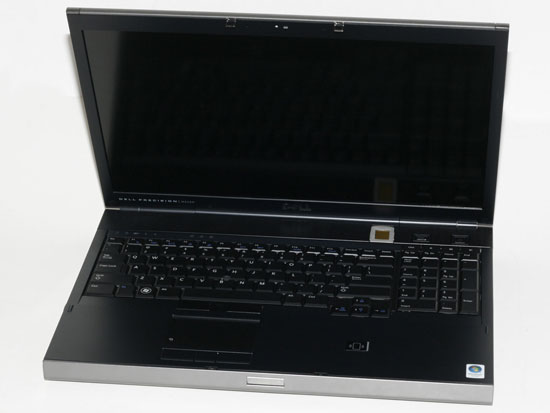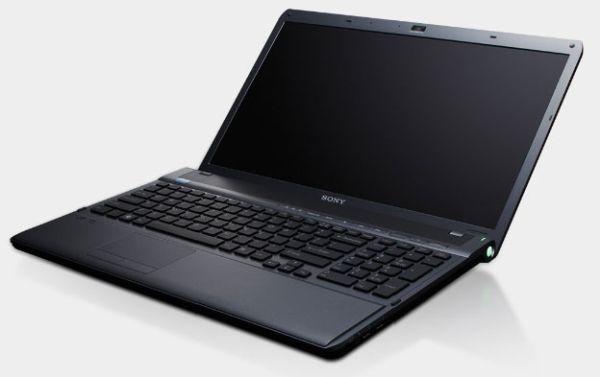Holiday Buyer's Guide: Notebooks
by Dustin Sklavos on November 15, 2010 9:00 PM EST- Posted in
- Laptops
- Guides
- Holiday 2010
Best Mobile Workstation: Dell Precision M6500 (Starting at $1700)
Figuring out the right workstation machine to recommend actually proved fairly difficult. Lenovo offers a healthy selection, but tend to be priced fairly high (though there's something to be said for a workstation that includes a built-in second screen). HP's EliteBook series offers their well-respected Dreamcolor screens, but those add a nasty $600 to the pricetag of the notebook.

In the end we went with the well-respected, well-known Dell Precision M6500. The M6500 is compelling because it offers all the accoutrement we want from a workstation: every form of modern connectivity, the most powerful Intel processors on the market, workstation-class graphics, and best of all, a 16:10 aspect RGB LED backlit screen. It's also capable of supporting up to four DIMMs of memory (maxing out at a staggering 32GB) and has three drive bays that can be configured for RAID. You can read more about it in our full review.
Put simply, the M6500 offers everything while starting at a reasonable price (currently $500 off at the time of writing!), and for that it's easy to see why it's our primary pick for a workstation notebook. Toss in a quad-core 740QM, 2x2GB RAM, and the stunningly beautiful RGB LED display and you're still looking at a fairly reasonable $2250.
Workstation Runner Up: Sony F Series (Starting at $1000)
Of course, if you can't afford the fat price tag on the M6500, you may find your options in the marketplace painfully limited. ExpressCard and FireWire are becoming increasingly rarefied, but Sony has your back with their F series. These notebooks were recently updated with the i7-x40QM processors and 400M GeForce parts, and they offer all the connectivity trimmings.
The flipside is that the Sony F series is a consumer-grade notebook capable of handling workstation-level tasks, but you lose a lot making the downgrade. You can still get a 1080p screen, but it's going to pale in comparison to the 1920x1200 RGB LED backlit screen the M6500 can bring to the table. You're also going to be reduced to a single drive bay, less memory, and less powerful graphics. Unfortunately, it also wins by default. Sony is really the only company outside of Apple producing notebooks with this level of connectivity for this market.
Other Alternatives?
We already mentioned the HP and Lenovo brands as being viable mobile workstation candidates. Lenovo has the 15.6" ThinkPad W510 starting at $1300, with a $250 95% gamut LCD upgrade available. The Quadro FX 880M is the workstation version of the GT 330M, which is at least a big step up from the anemic 360M. The bigger ThinkPad W701 and W701ds have similar features relative to the M6500, but with a starting price of $2500 ($3300 for the dual-screen model) you can understand why these are simply alternatives. HP's EliteBook line retreads the same ground: there's the Quadro FX 880M in the EliteBook 8540w, only with a fast dual-core i7-640M, or the larger 8740w bumps up the size, performance, options, and price. Like HP and Lenovo, Dell also has the smaller Precision M4500 available in a 15.6" chassis.
If your work is buying the workstation, our recommendations probably won't matter much—you get whatever the IT department decides—but unless you have a sale or other special offer, Dell looks to win handily in bang-for-the-buck.











50 Comments
View All Comments
FATCamaro - Monday, November 15, 2010 - link
For most comparable system it is around 5-20% which isn't steep.Cuhulainn - Monday, November 15, 2010 - link
I'm 5'9" and weigh 168 lbs. This is in the normal weight range for body mass index.If I gained 20% more weight, I'd weigh 200 lbs and would be considered obese.
Just sayin'.
th3pwn3r - Saturday, November 20, 2010 - link
What in the world does BMI have to do with anything? Not to mention BMI is a failed investment that they won't let die. If you're judged as being obese just because you're a certain weight/height ratio it's stupid. Most body builders and fitness athletes are classified as obese through BMI.JarredWalton - Monday, November 15, 2010 - link
Well, here's steep for the MacBook Pro 15:- 2.4GHz Intel Core i5 (i5-520M or i5-450M?)
- 4GB (2x2GB) RAM
- 320GB 5400rpm Hard Drive
- SuperDrive
- NVIDIA GeForce GT 330M 256MB Graphics
- 15.4" Glossy 1440x900
- Secure Digital (SD) Card Slot
- iSight Webcam, Bluetooth 2.1+EDR
- 802.11n AirPort Extreme
- Mac OS X 10.6 Snow Leopard, 5.6 lb
Total price: $1707 online, $1800 from Apple.
I get more than that in every area with an XPS L501x, with a price of just $1000. Heck, we can toss out the Dell Precision M4500 as another comparison, which is really quite expensive since it's a mobile workstation:
Windows 7 Professional 64-bit
Core i5-520M (2.40GHz)
3 Year Basic Limited Warranty and 3 Year Next Business Day On-Site Service
NVIDIA Quadro FX 880M 1GB
2x2GB DDR3-1333MHz
15.6" HD+ (1600 x 900) Anti-Glare LED Display with Premium Panel Guarantee
320GB 7200rpm Hard Drive
8X DVD+/-RW
6-cell (60Wh) Lithium Ion Battery
Dell Wireless 1501 802.11b/g/n Half Mini Card
Dell Wireless 375 Bluetooth Module
Integrated webcam with microphone
Internal English Backlit Keyboard
Total price: $1750 (though granted that's with the current sale Dell is doing--which they do all the time)
There's no question NVIDIA charges more for Quadro 880M vs. GT 330M, though they're basically the same chip. Many of the other areas are a wash as well, but the upgraded LCD should be good (hopefully as good as the MacBook, but without testing I don't know). And of course, we're comparing 3-year warranty with on-site service to the standard 1-year Apple store warranty. This is about as close as the comparison gets.
For consumer oriented offerings, the Dell XPS and HP Envy 14 cost about half of the MacBook Pro 15 while delivering similar features. Yes, you can complain about the XPS aesthetics, but they do manage to deliver a lot for the price. So you're looking at Dell on the one hand making the XPS 15 with all the features that Apple MBP 15 has but worse aesthetics and a price of $1000. On the other, you can't actually find anything else with a decent LCD and build quality unless you move into business laptops (which not surprisingly carry a price premium), and even then Apple is priced higher for what you get.
I suppose the real question is to define "steep". 5% markup on Apple relative to Windows laptops if you include a student discount perhaps, but for average buyers the markup is at least 20%, and I'd qualify that as pretty steep considering the cutthroat nature of the computer industry.
FATCamaro - Tuesday, November 16, 2010 - link
Point taken. The XPS L501x is a winner vs the 15" MBP for value.MeesterNid - Tuesday, November 16, 2010 - link
Right, but if we really are talking mobile here then you have to consider the battery power and the weight of the machines. I'm not sure about the Dell, but the MBP is a fairly portable (not too heavy) device that gives you a fair amount of battery-powered computing time.awaken688 - Wednesday, November 17, 2010 - link
You are comparing the chips inside which is very important. But what about weight and battery.I'm still waiting to see a true side by side with the price comparison.
I still think the Apple 15 is overpriced, but some people value certain things much higher than others such a true portability (weight and battery).
Separate topic:
Long term battery test. I have 3 friends that just bought Apple laptops last year (2 MBP 15", 1 vanilla MacBook). Both are their batteries killed my PC laptop at the start. Now all 3 of their batteries can't even make it through a 1 hour meeting/class unplugged while using it.
bah12 - Wednesday, November 17, 2010 - link
Well certainly the 20% buys you some weight/battery life (hell 20% better get you something), but then subtract from those gains the hassle of OSX or Bootcamp, and the small gain is not worth it IMO. Its strictly a matter of personal opinion of course.Also all batteries degrade over time, as your experience shows Apple is not immune to this either. So replacement part cost should be a concern, and I'm sure you will see that Apple tax sneak it's way back in there too.
awaken688 - Thursday, November 18, 2010 - link
I can't comment on OSX. Most people that use Macs enjoy OS-X. I know Anand and company does. I still don't understand why someone besides the Sony Vaio Z can't produce a similar quality (speed, battery, weight, screen, usability) to a MacBook Pro. Yes I know it will be just as expensive, but we really don't even have a choice.Maybe Jared knows of one.
- 15"
- 1680x1050 Quality Matte Screen (no I don't want 1920x1080 or 1920x1200. I have a 1920x1200 Dell Precision Mobile Workstation now and that resolution is just too intense for that screen IMO)
- Core i5/i7
- 4GB+ Ram
- Decent GPU (I don't care about games. That is what consoles and desktops are for)
- Under 6 lbs.
- Less than 1" thick (although 1.1" is alright)
- Battery life under light surfing over 5 hours
I know this is a MacBook Pro basically, but is there anything out there that is like this other than Apple's offering?
8steve8 - Monday, November 15, 2010 - link
Anandtech is not entirely different, but the whole geeky media is over-obsessed with gpu performance on laptops. Very few people rely on a portable laptop for demanding 3d games, and the core i5/i3/i7 gpu is fine for non-cutting edge games like warcraft 3, and playing any sort of compressed video.Stressing gpu performance in the media forces the mfgrs to create laptops with discrete graphics, which means wasted volume, weight and energy.
case in point, even the new lenovo U260 seems to have allocated space for a gpu, in its 0.7" thick frame, and partially because of this, it can only fit a 29Whr battery.
http://shop.lenovo.com/gbweb/gb/en/learn/products/...
^ ^ you will see discrete graphics is an option... amazingly stupid trade-off on an ultra-portable.
apple stubbornly sticking to nvidia for GPU, at the cost of several years of cpu progress is not even worth a second of debate, especially on an 11" machine.
I'm not hating on anandtech, just the whole industry, reviews shape future designs, and as we are seeing now, even with good-enough-for-non-gamers igp performance, laptops of all sizes are being outfitted with discrete options. Stupid.